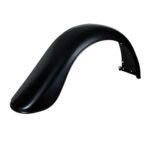Maintaining your vehicle’s cooling system is crucial for preventing overheating and ensuring optimal engine performance. Understanding the different Car Coolant Parts and their functions can empower you to identify potential issues early and perform necessary maintenance. This guide will walk you through the key components of your car’s cooling system, explaining their roles and common problems.
1. Radiator: The Heat Exchanger
The radiator is a vital car coolant part responsible for dissipating heat from the engine coolant. As hot coolant flows from the engine into the radiator, air passes through its fins, cooling the fluid before it recirculates back into the engine. Effective radiator function is essential for maintaining optimal engine temperature. Over time, radiators can become less efficient due to external debris blockage or internal corrosion and buildup.
Alt text: Car radiator showcasing its core structure for engine coolant heat dissipation, highlighting its role as a key car coolant part.
2. Thermostat: Regulating Coolant Flow
The thermostat is a mechanical valve that controls the flow of coolant to the engine based on its temperature. This crucial car coolant part remains closed when the engine is cold, restricting coolant circulation to help the engine reach its optimal operating temperature quickly. Once the engine reaches the desired temperature, typically around 195 degrees Fahrenheit (90 degrees Celsius), the thermostat opens, allowing coolant to flow through the engine and radiator, preventing overheating. A malfunctioning thermostat can cause either overheating or undercooling, both detrimental to engine health.
Alt text: Automotive thermostat component, a key car coolant part regulating engine temperature by controlling coolant circulation.
3. Water Pump: Circulating the Coolant
The water pump is the heart of the cooling system, responsible for circulating coolant throughout the engine and radiator. Driven by the serpentine belt or timing belt, this car coolant part ensures a constant flow of coolant to remove heat from the engine and transport it to the radiator for cooling. Water pumps are subject to wear and tear. Common issues include leaks from seals and bearing failures, which can impede coolant circulation and lead to overheating.
Alt text: Engine water pump, a critical car coolant part driven by a belt to ensure continuous coolant flow through the engine.
4. Cooling Fans: Enhancing Airflow
Cooling fans are essential car coolant parts that augment airflow through the radiator, especially when the vehicle is stationary or moving slowly. Older rear-wheel-drive vehicles often utilize a mechanical fan driven by the serpentine belt. Modern vehicles, including front-wheel-drive models, typically use electric fans. These electric fans are activated based on coolant temperature and air conditioning system operation. Fan malfunctions, whether mechanical clutch failures in older fans or electrical issues in newer ones, can significantly reduce cooling efficiency, particularly in hot weather or during stop-and-go traffic.
Alt text: Electric cooling fans positioned in front of a car radiator, essential car coolant parts for forced air circulation and temperature regulation.
5. Radiator and Heater Hoses: Coolant Pathways
Radiator hoses and heater hoses are crucial conduits within the cooling system. Radiator hoses, typically the upper and lower hoses, connect the radiator to the engine, facilitating coolant circulation between these major components. Heater hoses, connected to the cooling system, direct warm coolant to the heater core, providing cabin heating. These car coolant parts are made of rubber and are prone to degradation over time due to heat and pressure. Leaks in any hose can lead to coolant loss and engine overheating.
Alt text: Car radiator and heater hoses, key car coolant parts that act as pathways for coolant flow between engine and radiator.
6. Serpentine Belt: Powering the Water Pump and Fan
The serpentine belt (or V-belts in older vehicles) is responsible for driving essential engine accessories, including the water pump and, in some cases, the mechanical cooling fan. A functioning serpentine belt is vital for the operation of these car coolant parts. If the belt breaks or slips due to wear, the water pump will stop circulating coolant, and the fan will cease to operate, leading to rapid engine overheating. Regular inspection and timely replacement of the serpentine belt are essential preventative maintenance.
Alt text: Serpentine belt routing around pulleys, powering essential car coolant parts like the water pump in an engine system.
7. Coolant Temperature Sender and Sensor: Monitoring Engine Heat
The coolant temperature sender and sensor are critical for monitoring engine temperature. The sensor provides temperature readings to the engine control unit (ECU), which uses this data to manage cooling fan operation and other engine functions. The sender transmits temperature information to the dashboard gauge, providing the driver with a visual indication of engine temperature. If coolant leaks and the sender is no longer immersed in coolant, it may provide a false low-temperature reading, masking an overheating condition. These car coolant parts are essential for accurate temperature monitoring and preventing severe engine damage.
Alt text: Coolant temperature sensor, a car coolant part responsible for monitoring and reporting engine coolant temperature to the vehicle’s systems.
Understanding these essential car coolant parts and their functions is the first step in maintaining a healthy cooling system. Regular inspections and prompt attention to any signs of cooling system issues can prevent costly engine damage and ensure your vehicle operates reliably. If you suspect a problem with your cooling system, it’s always best to consult a qualified mechanic for diagnosis and repair.
